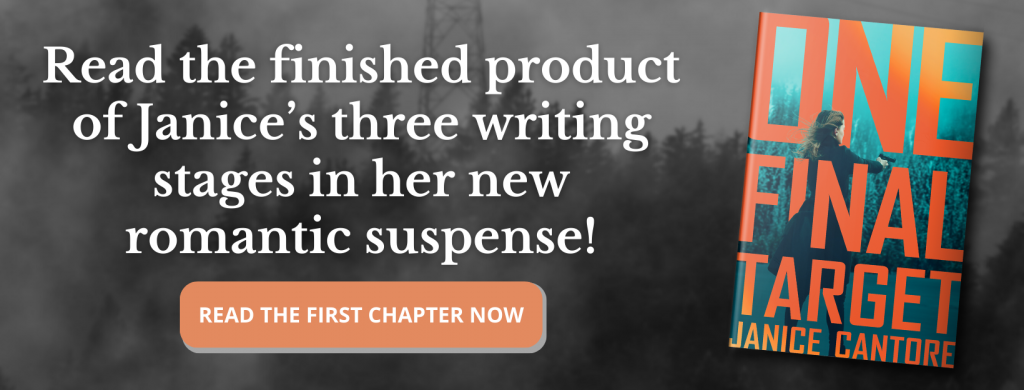Author Janice Cantore is a former police officer who now writes romantic suspense novels. Janice writes suspense that keeps readers engrossed and leaves them inspired. In her latest novel, One Final Target, a sergeant and a detective team up to discover who was behind an explosion that put one of their own in the crosshairs. In this guest post by Janice Cantore, go behind the scenes and learn the three stages of Janice’s writing process.
One Final Target, releasing in February 2024, is my fourteenth published novel with Tyndale House. Saying a novel is published is so easy compared to the process that began with two or three sentences of an idea. The writing process for me is full of ups and downs. When I sat down after the new year to start the draft of my next novel, I wondered why, after so many books, it is still so daunting, and why can’t I be more organized? I have a great concept in my head, but it comes out on the page in a raggedy line of fits and starts.
My writing process is messy and unorganized. I often envy those organized writers who neatly and easily churn out book after book seemingly without effort. My chaotic writing process can be divided into three stages. One: blank page, jumble of thoughts. Two: jumble of thoughts has become jumble of words on page after page. Three: the wrestling process, where after typing, erasing, and typing again, the story takes shape and just needs polish.

Stage One
It’s stage one, and I have a blank page in front of me. I have what I believe is a great concept in my head. My problem here is that I think faster than I type. The idea in my head is running like a 100-meter sprinter and the words I type on the page resemble the 80-year-old grandma finishing her first marathon. I recognize that I do need to get words down; I can’t edit a blank page. So I type as fast as I can. I also revise as I go, a big no-no in some books on writing. Still, I keep typing, pushing through page after page, which will eventually spill me into stage two.
Stage Two
Stage two is chaos. There are pages and pages of story in front of me. But as I read through, I often find myself asking questions like, “What was I thinking?” “What happened to Bill on page ten, and who is Haley?” “And why in the world did I ever consider myself a writer?” The plot is weak, my characters are flat, the timeline is off. Three hundred pages of gibberish. This is where nail biting and hair pulling come into play. And rethinking the original idea. Also in here is the fear that I’ll never meet the word count or the deadline. I have the story down, but was it ever as good as I thought it was? I’ll probably call my agent in a panic and ask her to read what I have. Does any of it work?
Stage Three
Thankfully at some point in the chaos, I find that I have transitioned to stage three. Wonder of wonders, I have a coherent story! Now I only have to wrestle with the details and come to a satisfying conclusion. Here I usually kill trees by printing the story a number of times, refining, editing, tying up loose ends. Oh look, there’s a satisfying twist! Where did that come from? There is still self-doubt, of course. I like the story (sometimes I surprise myself), and it works, but will it satisfy the publisher? Is it what they were looking for? Will readers like it? Those kinds of questions never stop. But I eventually get to a place where I can type, “The End,” and that is immensely satisfying.
I have a love-hate relationship with my writing process. It is a process, messy and uneven, but it’s all mine. I have a friend I golf with, and when I hit a good shot, she’ll say, “I love golf for you.” When the book is finished and sent away to my editor, and they like it, I love the writing process for me. Until I sit down to begin again, and then it’s all jumbled chaos.



